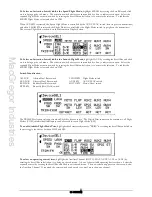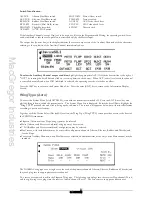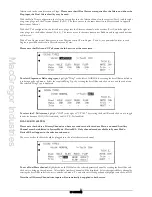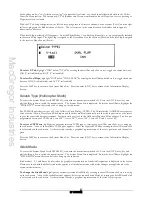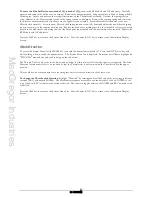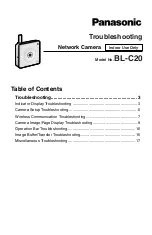
MacGregor Industries
3
rotating the Scroll Bar will increment or decrement the figures. A Scroll Bar click is always used to exit from a sub menu.
When appropriate, block arrows on the screen point to any active side input keys.
INPUT KEYS
There are four keys on the left of the display. In conjunction with the Scroll Bar, they are used to navigate the menu
systems.
ENT (Enter) Used to gain entry into the System Menu List and direct entry into the last selected Function Menu
choice. From the System or Function Menu sub menus, it exits to the Information Display Screen.
LIST (List)
Used to gain entry into the Function Menu. Returns the display, from a sub menu, to the Main Menu.
CLR (Clear) Returns a menu figure to the system default. When indicated, stores defined values.
Unmarked
Screen display indicates function.
ADVANCED DIGITAL TRIM
When a Digital Trim lever is moved, the appropriate channel Digital Trim position is displayed on the screen for a few
seconds as a Bar Graph, vertically for Elevator and Throttle and horizontally for Aileron and Rudder. In addition, as the
value is changed, an audio indication of the trim position is given with a rising or falling tone. The tone and trim action
pause at neutral to assist in locating the neutral position.
The trim step rate may be varied as described in System Mode - Trim Step.
All Digital Trim settings can be automatically remembered for each Flight Mode so that separate trim facilities are not
necessary. See System Mode - DeviceSEL.
CONTROL STICK LENGTH
The stick units of JR radio equipment feature adjustable length sticks. Use the supplied allen key to make adjustments.
Loosen the grub screw by turning the allen key anticlockwise. Adjust the stick length to your requirement and lock the stick
in place by turning the grub screw clockwise. Please note that optional coloured sticks and long/short sticks are available
from your Local Model Shop.
CONTROL STICK TENSION
The stick tension may be adjusted to suit your preference. To adjust the tension, remove the RF Module, NiCad battery and
the back cover screws (six screws). Remove the transmitter back, being careful not to bend or damage the RF Module pins.
The tension screws protrude from the back of the stick assemblies, immediately adjacent to the tension springs. Adjust each
screw for the desired tension (anticlockwise to loosen the stick feel, clockwise to tighten the feel). Replace the back cover,
making sure that the side cheek levers are correctly located in the side cheeks and noting that the side cheek pads are
mounted with the slot towards the case back. Replace the RF Module and NiCad battery.
DSC LEAD
The Direct Servo Connection (DSC) allows the servos to be controlled without switching the transmitter on. The lead
bypasses the RF module and allows operation of the radio equipment without the danger of interference to other models.
To use the DSC connection, plug the DSC cable into the transmitter and then into the receiver’s charge lead. The
transmitter Information Display Screen will light but no RF will be transmitted. DO NOT TURN THE TRANSMITTER
ON! Turn the receiver ON to operate the servos direct from the transmitter.
Note: The DSC function will only operate with a JRC498D Deluxe Switch harness, or the JRC498 Heavy Duty Switch
harness. These switch harnesses include the orange signal wire, as well as the brown and red power wires.
BACKUP
The PCM9XII no longer utilises a Lithium Battery for backup. Model settings are now stored on Flash Memory that is
believed to have an unlimited life.
Summary of Contents for PCM9XII
Page 1: ...MacGregor Industries MACGREGOR INDUSTRIES Instruction Manual PCM9XII ...
Page 4: ...MacGregor Industries This page is intentionally blank ...
Page 43: ...MacGregor Industries 39 HELI ...
Page 65: ...MacGregor Industries 61 AERO ...
Page 85: ...MacGregor Industries 81 GLIDER ...
Page 86: ...MacGregor Industries This page is intentionally blank ...
Page 87: ...MacGregor Industries This page is intentionally blank ...

















